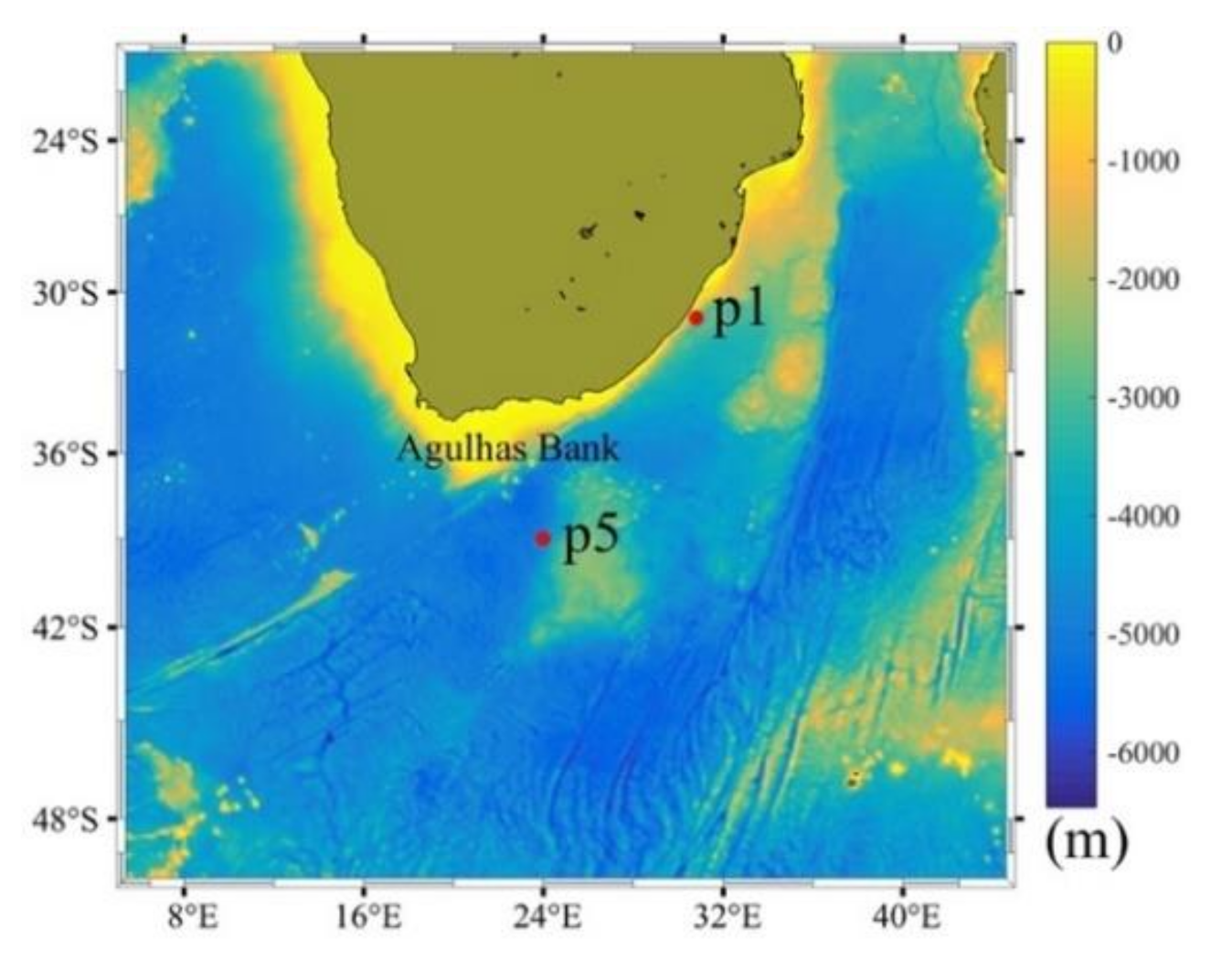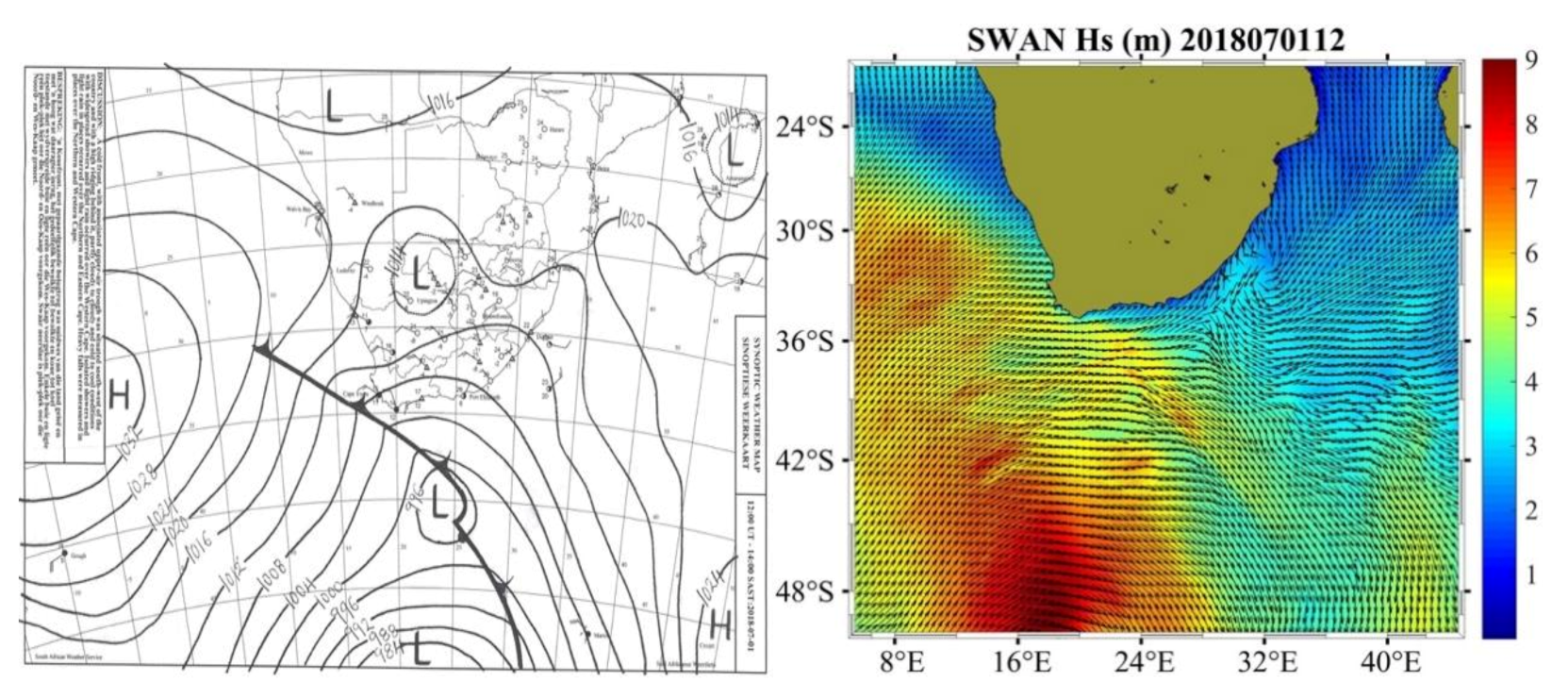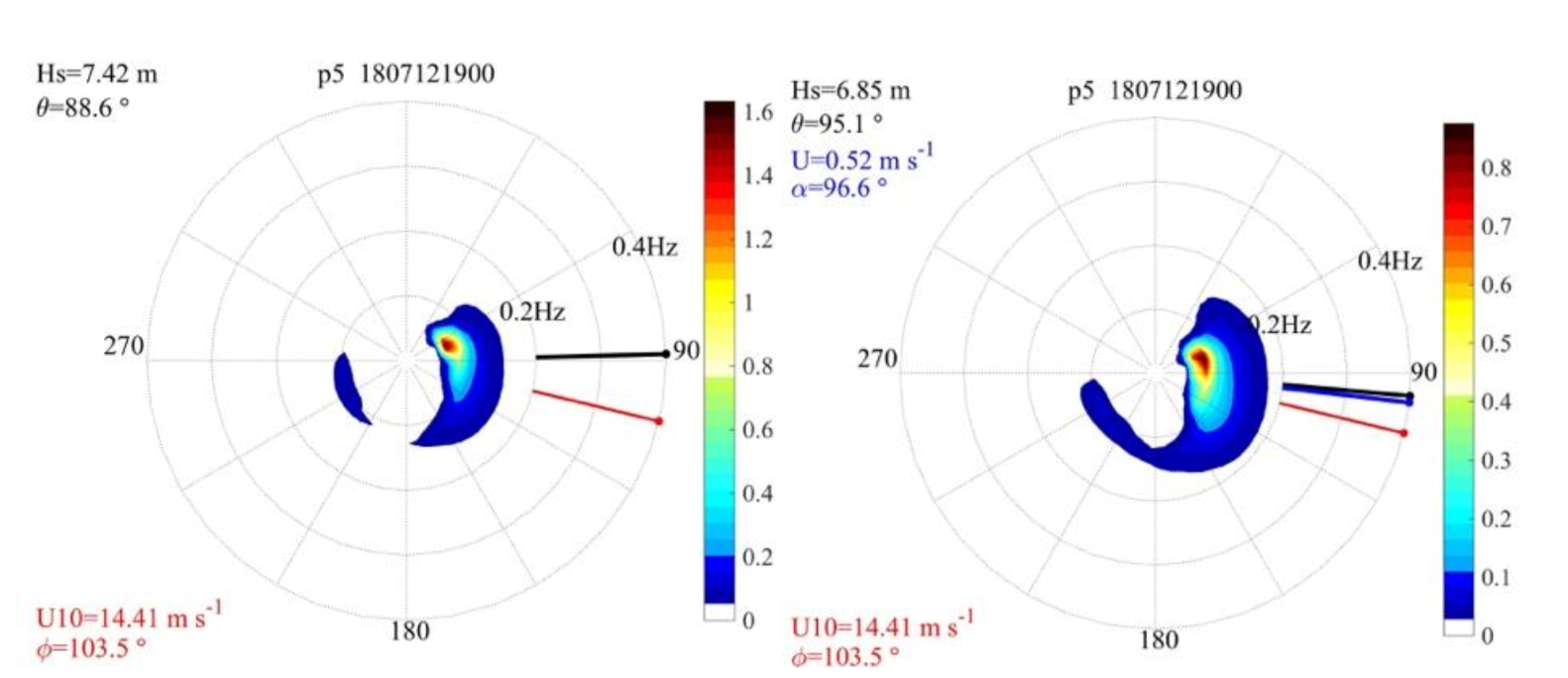Extreme Waves in the Agulhas Current Region Inferred from SAR Wave Spectra and the SWAN Model
Abstract
:1. Introduction
2. Materials and Methods
2.1. Wave Model Setup and Forcing
2.2. Validation of the Numerical Simulations
2.3. ESA Sentinel-1 SAR Wave Mode Data
3. Results and Discussions
3.1. Winter Synoptic Conditions
3.2. Temporal Analysis
3.3. Composite Spatial Analysis of the Extreme Waves
4. Analysis of the Wave Spectra
4.1. Influence of Currents on the Modelled 2d Wave Spectra
4.2. Case 1: Waves in Opposing Current (P1)
4.3. Case 2: Waves and Current Not Aligned (P5)
4.4. Case 3: Waves in a Following Current (P5)
5. Conclusions
Author Contributions
Funding
Data Availability Statement
Acknowledgments
Conflicts of Interest
References
- Guedes Soares, C.; Teixeira, A.P. Risk assessment in maritime transportation. Reliab. Eng. Syst. Saf. 2001, 74, 299–309. [Google Scholar] [CrossRef]
- Guedes Soares, C.; Bitner-Gregersen, E.; Antao, P. Analysis of the Frequency of Ship Accidents under Severe North Atlantic Weather Conditions. In Proceedings of the Conference on Design and Operation for Freak Conditions II, Royal Institution of Naval Architects (RINA), London, UK, 6–7 November 2001; pp. 221–230. [Google Scholar]
- Vettor, R.; Guedes Soares, C. Development of a ship routing system. Ocean Eng. 2016, 123, 1–14. [Google Scholar] [CrossRef]
- Draper, L. “Freak” ocean waves. Weather 1966, 21, 2–4. [Google Scholar] [CrossRef]
- Dean, R.G. Freak waves: A possible explanation. In Water Wave Kinetics; Tørum, A., Gudmestad, O.T., Eds.; (NATO ASI Series (E Applied Sciences)); Springer: Dordrecht, The Netherlands, 1990; Volume 178. [Google Scholar] [CrossRef]
- Fedele, F.; Brennan, J.; de León, S.P.; Dudley, J.; Dias, F. Real world ocean freak waves explained without the modulational instability. Sci. Rep. 2016, 6, 27715. [Google Scholar] [CrossRef] [PubMed]
- Dudley, J.M.; Genty, G.; Mussot, A.; Chabchoub, A.; Dias, F. Rogue waves and analogies in optics and oceanography. Nat. Rev. Phys. 2019, 1, 675–689. [Google Scholar] [CrossRef]
- Lavrenov, I. The wave energy concentration at the Agulhas current of South Africa. Nat. Hazards 1998, 17, 117–127. [Google Scholar] [CrossRef]
- Tamura, H.; Waseda, T.; Miyazawa, Y. Freakish sea state and swell-windsea coupling: Numerical study of the Suwa-Maru incident. Geophys. Res. Lett. 2009, 36, L01607. [Google Scholar] [CrossRef] [Green Version]
- Cavaleri, L.; Bertotti, L.; Torrisi, L.; Bitner-Gregersen, E.; Serio, M.; Onorato, M. Rogue waves in crossing seas: The Louis Majesty accident. J. Geophys. Res. 2012, 117, C00J10. [Google Scholar] [CrossRef]
- Waseda, T.; In, K.; Kiyomatsu, K.; Tamura, H.; Miyazawa, Y.; Iyama, K. Predicting freakish sea state with an operational third-generation wave model. Nat. Hazards Earth Syst. Sci. 2014, 14, 945–957. [Google Scholar] [CrossRef] [Green Version]
- Ponce de León, S.; Bettencourt, J.H.; Brennan, J.; Dias, F. Evolution of the Extreme Wave Region in the North Atlantic Using a 23 Year Hindcast. In Proceedings of the ASME. International Conference on Offshore Mechanics and Arctic Engineering, Volume 2: Structures, Safety and Reliability (OMAE2015):V003T02A019, Newfoundland, NL, Canada, 31 May–5 June 2015. [Google Scholar] [CrossRef]
- Ponce de León, S.; Bettencourt, J.H.; Dias, F. Comparison of hindcasted extreme waves with a Doppler radar measurements in the North Sea. Ocean Dyn. 2017, 67, 103–115. [Google Scholar] [CrossRef]
- Mallory, J.K. Freak waves in the south-east coast of South Africa. Int. Hydrogr. Rev. 1974, 51, 99–129. [Google Scholar]
- Gründlingh, M.L. TOPEX/Poseidon observes wave enhancement in the Agulhas current. AVISO Altimeter Newsl. 1994, 3. [Google Scholar]
- Krug, M.; Swart, S.; Gula, J. Submesoscale cyclones in the Agulhas current. Geophys. Res. Lett. 2017, 44, 1–9. [Google Scholar] [CrossRef] [Green Version]
- Lutjeharms, J.R.E. The Agulhas Current; Springer: Berlin, Germany; New York, NY, USA, 2006; Available online: https://link.springer.com/content/pdf/10.1007/3-540-37212-1.pdf (accessed on 10 March 2019)ISBN 10 3-540-42392-3.
- Johannessen, J.A.; Chapron, B.; Collard, F.; Kudryavtsev, V.; Mouche, A.; Akimov, D.; Dagestad, K.F. Direct ocean surface velocity measurements from space: Improved quantitative interpretation of Envisat ASAR observations. Geophys. Res. Lett. 2008, 35, L22608. [Google Scholar] [CrossRef] [Green Version]
- Rouault, M.J.; Mouche, A.; Collard, F.; Johannessen, J.A.; Chapron, B. Mapping the Agulhas current from space: An assessment of ASAR surface current velocities. J. Geophys. Res. 2010, 115, C10026. [Google Scholar] [CrossRef] [Green Version]
- Krug, M.; Tournadre, J.; Dufois, F. Interactions between the Agulhas Current and the eastern margin of the Agulhas Bank. Cont. Shelf Res. 2014, 81, 67–79. Available online: https://www.sciencedirect.com/science/article/pii/S0278434314000843 (accessed on 15 April 2020). [CrossRef] [Green Version]
- Bang, N.D. Dynamic interpretations of a de- tailed surface temperature chart of the Agulhas Current retroflexion and fragmentation area. S. Afr. Geogr. J. 1970, 52, 67–76. [Google Scholar] [CrossRef]
- Lutjeharms, J.R.E.; van Ballegooyen, R.C. The retroflection of the Agulhas Current. J. Phys. Oceanogr. 1988, 18, 1570–1583. [Google Scholar] [CrossRef]
- Lutjeharms, J.R.E. Features of the southern Agulhas Current circulation from satellite remote sensing. S. Afr. J. Sci. 1981, 77, 231–236. Available online: https://journals.co.za/content/sajsci/77/5/AJA00382353_1526 (accessed on 3 January 2018).
- Broecker, W.S. The great ocean conveyor. Oceanography 1991, 4, 79–89. [Google Scholar] [CrossRef]
- Johannessen, J.A.; Chapron, B.; Collard, F.; Backeberg, B. Use of SAR Data to Monitor the Greater Agulhas Current. In Remote Sensing of the African Seas; Barale, V., Gade, M., Eds.; Springer: Cham, Switzerland, 2014; ISBN 978-94-017-8007-0. [Google Scholar] [CrossRef]
- Young, I.R.; Ribal, A. Multiplatform evaluation of global trends in wind speed and wave height. Science 2019, 364, 548–552. [Google Scholar] [CrossRef]
- Young, I.R.; Zieger, S.; Babanin, A. Global trends in wind speed and wave height. Science 2011, 332, 451–455. [Google Scholar] [CrossRef] [PubMed]
- Quilfen, Y.; Yurovskaya, M.; Chapron, B.; Ardhuin, F. Storm waves focusing and steepening in the Agulhas current: Satellite observations and modeling. Remote Sens. Environ. 2018, 216, 561–571. [Google Scholar] [CrossRef] [Green Version]
- Ardhuin, F.; Gille, S.T.; Menemenlis, D.; Rocha, C.B.; Rascle, N.; Chapron, B.; Gula, J.; Molemaker, J. Small-scale open-ocean currents have large effects on wind- wave heights. J. Geophys. Res. Oceans 2017, 122, 4500–4517. [Google Scholar] [CrossRef] [Green Version]
- Rapizo, H.; Durrant, T.H.; Babanin, A.V. An assessment of the impact of surface currents on wave modeling in the Southern Ocean. Ocean Dyn. 2018, 68, 939–955. [Google Scholar] [CrossRef]
- Booij, N.; Ris, R.C.; Holthuijsen, L.H. A third-generation wave model for coastal regions. 1. Model description and validation. J. Geophys. Res. 1999, 104, 7649–7666. [Google Scholar] [CrossRef] [Green Version]
- SWAN Team. SWAN Scientific and Technical Documentation; Delft University of Technology: Delft, The Netherlands, 2019. [Google Scholar]
- Amante, C.; Eakins, B.W. ETOPO1 1 Arc-Minute Global Relief Model: Procedures, Data Sources and Analysis; NOAA Technical Memorandum NESDIS NGDC-24; National Geophysical Data Center NOAA: Boulder, CO, USA, 2009. [Google Scholar] [CrossRef]
- IFS Documentation-Cy46r1. Operational Implementation, 6 June 2019. Part VII: ECMWF Wave Model; European Centre for Medium-Range Weather Forecasts: Shinfield Park, Reading, UK; p. 99. Available online: https://www.ecmwf.int/sites/default/files/elibrary/2019/Part-VII-ECMWF-Wave-Model.pdf (accessed on 2 February 2021).
- Hersbach, H.; Bell, W.; Berrisford, P.; Horányi, A.; Muñoz-Sabater, J.; Nicolas, J.; Radu, R.; Schepers, D.; Simmons, A.; Soci, C.; et al. Global Reanalysis: Goodbye ERA-Interim, Hello ERA5; ECMWF Newsletter: Reading, UK, 2019; pp. 17–24. [Google Scholar] [CrossRef]
- Lellouche, J.-M.; Greiner, E.; Le Galloudec, O.; Garric, G.; Regnier, C.; Drevillon, M.; Benkiran, M.; Testut, C.-E.; Bourdalle-Badie, R.; Gasparin, F.; et al. Recent updates to the Copernicus Marine Service global ocean monitoring and forecasting real-time 1∕12°high-resolution system. Ocean Sci. 2018, 14, 1093–1126, Copernicus Publications. [Google Scholar] [CrossRef] [Green Version]
- Law Chune, S.; Nouel, L.; Fernandez, E.; Derval, C. Product User Manual for the Global Ocean Sea Physical Analysis and Forecasting Products; CMEMS: Brussels, Belgium, 2019; 30p, Available online: http://marine.copernicus.eu/services-portfolio/access-to-products/?option=com_csw&view=details&product_id=GLOBAL_ANALYSIS_FORECAST_PHY_001_024 (accessed on 2 February 2021).
- Komen, G.J.; Cavaleri, L.; Donelan, M.A.; Hasselmann, K.; Hasselmann, S.; Janssen, P.A.E.M. Dynamics and Modelling of Ocean Waves; Cambridge University Press: Cambridge, UK, 1994; Available online: https://www.cambridge.org/core/books/dynamics-and-modelling-of-ocean-waves/767155B50D6E29B0F62729F29C2DE124 (accessed on 2 February 2021).
- Komen, G.J.; Hasselmann, S.; Hasselmann, K. On the existence of a fully developed wind-sea spectrum. J. Phys. Oceanogr. 1984, 14, 1271–1285. [Google Scholar] [CrossRef]
- Hasselmann, S.; Hasselmann, K.; Allender, J.H.; Barnett, T.P. Computations and parameterizations of the nonlinear energy transfer in a gravity-wave spectrum, Part II. J. Phys. Oceanogr. 1985, 15, 1378–1391. [Google Scholar] [CrossRef] [Green Version]
- Janssen, P.A.E.M. Quasi-linear theory of wind wave generation applied to wave forecasting. J. Phys. Oceanogr. 1991, 21, 1631–1642. [Google Scholar] [CrossRef] [Green Version]
- Janssen, P.A.E.M. Nonlinear four-wave interactions and freak waves. J. Phys. Oceanogr. 2003, 33, 863–884. [Google Scholar] [CrossRef]
- Ardhuin, F.; Stopa, J.; Chapron, B.; Collard, F.; Smith, M.; Thomson, J.; Doble, M. Measuring Ocean Waves in Sea Ice Using SAR Imagery: A Quasi-Deterministic Approach Evaluated with Sentinel-1 and in Situ Data. Remote Sens. Environ. 2016, 189, 211–222. [Google Scholar] [CrossRef] [Green Version]
- Stopa, J.E.; Mouche, A. Significant wave heights from Sentinel-1 SAR: Validation and applications. J. Geophys. Res. Oceans 2017, 122, 1827–1848. [Google Scholar] [CrossRef] [Green Version]
- Rikka, S.; Pleskachevsky, A.; Jacobsen, S.; Alari, V.; Uiboupin, R. Meteo-marine parameters from Sentinel-1 SAR imagery: Towards near real-time services for the baltic sea. Remote Sens. 2018, 10, 757. [Google Scholar] [CrossRef] [Green Version]
- Johnsen, H.; Collard, F. Sentinel-1 Ocean Swell Wave spectra (OSW) Algorithm Definition NORUT Report 13/2009; NORUT: Narvik, Norway; ISBN 1890-5226. Available online: https://earth.esa.int/documents/247904/349449/S-1_L2_OSW_Detailed_Algorithm_Definition.pdf (accessed on 2 February 2021).
- Collard, F.; Chapron, B.; Johnsen, H. Sentinel-1 SAR Wave Mode, Technical Note, Boost Technologies, v1.0, Dec 2007. Available online: https://sentinel.esa.int/documents/247904/349449/S1_L2_OSW_Detailed_Algorithm_Definition.pdf (accessed on 2 February 2021).
- European Space Agency. Sentinel-1 User Handbook 2015; ESA: Paris, France; 64p, Standard Document, Issue 1, Rev. 2; Available online: https://sentinel.esa.int/documents/247904/685211/Sentinel-2_User_Handbook (accessed on 2 February 2021).
- Attema, E.; Cafforio, C.; Gottwald, M.; Guccione, P.; Guarnieri, A.M.; Rocca, F. Flexible dynamic block adaptive quantization for Sentinel-1 SAR missions. IEEE Geosci. Remote Sens. Lett. 2010, 7, 766–770. [Google Scholar] [CrossRef]
- Osborne, A.R.; Ponce de León, S. Properties of Rogue Waves and the Shape of the Ocean Wave Power Spectrum. In Proceedings of the ASME 36th International Conference on Offshore Mechanics and Arctic Engineering, Volume 3A: Structures, Safety and Reliability:V03AT02A013, Trondheim, Norway, 25–30 June 2017. [Google Scholar] [CrossRef]
- Ponce de León, S.; Osborne, A.; Guedes Soares, C. On the importance of the exact nonlinear interactions in the spectral characterization of rogue waves. In Proceedings of the 37th International Conference on Ocean, Offshore and Arctic Engineering, OMAE2018, Madrid, Spain, 17–22 June 2018. [Google Scholar] [CrossRef]
- Ponce de León, S.; Osborne, A.R. Role of Nonlinear Four-Wave Interactions Source Term on the Spectral Shape. J. Mar. Sci. Eng. 2020, 8, 251. [Google Scholar] [CrossRef] [Green Version]
- Guedes Soares, C. Representation of Double-Peaked Sea Wave Spectra. Ocean Eng. 1984, 11, 185–207. [Google Scholar] [CrossRef]
- Boukhanovsky, A.; Guedes Soares, C. Modelling of Multipeaked Directional Wave Spectra. Appl. Ocean Res. 2009, 31, 132–141. [Google Scholar] [CrossRef]
- Kudryavtsev, V.; Yurovskaya, M.; Chapron, B.; Collard, F.; Donlon, C. Sun glitter imagery of surface waves. Part 2: Waves transformation on ocean currents. J. Geophys. Res. Oceans 2017, 122, 1384–1399. [Google Scholar] [CrossRef]
- Ponce de León, S.; Guedes Soares, C. Numerical Modelling of the Effects of the Gulf Stream on the Wave Characteristics. J. Mar. Sci. Eng. 2021, 9, 42. [Google Scholar] [CrossRef]












| Parameters | Nested Grid |
|---|---|
| Geographical domain | 50° S, 19° S, 5° E, 45° E |
| Spatial resolution | 0.05° |
| Number of points | (801, 601) 481401 |
| Number of directional bands | 36 |
| Number of frequencies | 30 |
| Frequency range (Hz) | 0.03–0.5 Hz |
| Type of spectral model | Deep water |
| Propagation | Spherical |
| Wind input | Komen (1984) |
| Whitecapping dissipation | Janssen (1991) |
| Nonlinear interactions | 4 waves nonlinear interaction (DIA-discrete interactions approximation) (Hasselmann et al. 1985) |
| Current refraction | Yes |
| Wind input time step (hour) | 1 |
| Wave model output time step (hour) | 1 |
| Integration time step (seconds) | 300 |
| Wind data | Era-5 reanalysis |
| Ice | no |
| Bathymetry data | Etopo 1 |
| Parameter | Jason–3 | Jason–2 | Saral–Altika | Cryosat | ||||
|---|---|---|---|---|---|---|---|---|
| simulation | WWav | WCur | WWav | Wcur | WWav | WCur | WWav | WCur |
| bias | −0.6467 | 0.2382 | −0.5215 | 0.3467 | −0.5349 | 0.3161 | −0.6024 | 0.2303 |
| slope | 1.1351 | 0.9215 | 1.1047 | 0.8976 | 1.1108 | 0.9000 | 1.1323 | 0.9197 |
| S.I. | 0.1382 | 0.1061 | 0.1395 | 0.1120 | 0.1356 | 0.1020 | 0.1502 | 0.1073 |
| RMSE | 0.8142 | 0.5549 | 0.7466 | 0.6537 | 0.7270 | 0.5977 | 0.8033 | 0.5387 |
| cc | 0.9372 | 0.9557 | 0.9209 | 0.9300 | 0.9382 | 0.9518 | 0.9207 | 0.9438 |
| n | 9883 | 8492 | 8765 | 16696 | ||||
Publisher’s Note: MDPI stays neutral with regard to jurisdictional claims in published maps and institutional affiliations. |
© 2021 by the authors. Licensee MDPI, Basel, Switzerland. This article is an open access article distributed under the terms and conditions of the Creative Commons Attribution (CC BY) license (http://creativecommons.org/licenses/by/4.0/).
Share and Cite
Ponce de León, S.; Guedes Soares, C. Extreme Waves in the Agulhas Current Region Inferred from SAR Wave Spectra and the SWAN Model. J. Mar. Sci. Eng. 2021, 9, 153. https://doi.org/10.3390/jmse9020153
Ponce de León S, Guedes Soares C. Extreme Waves in the Agulhas Current Region Inferred from SAR Wave Spectra and the SWAN Model. Journal of Marine Science and Engineering. 2021; 9(2):153. https://doi.org/10.3390/jmse9020153
Chicago/Turabian StylePonce de León, Sonia, and C. Guedes Soares. 2021. "Extreme Waves in the Agulhas Current Region Inferred from SAR Wave Spectra and the SWAN Model" Journal of Marine Science and Engineering 9, no. 2: 153. https://doi.org/10.3390/jmse9020153
APA StylePonce de León, S., & Guedes Soares, C. (2021). Extreme Waves in the Agulhas Current Region Inferred from SAR Wave Spectra and the SWAN Model. Journal of Marine Science and Engineering, 9(2), 153. https://doi.org/10.3390/jmse9020153







